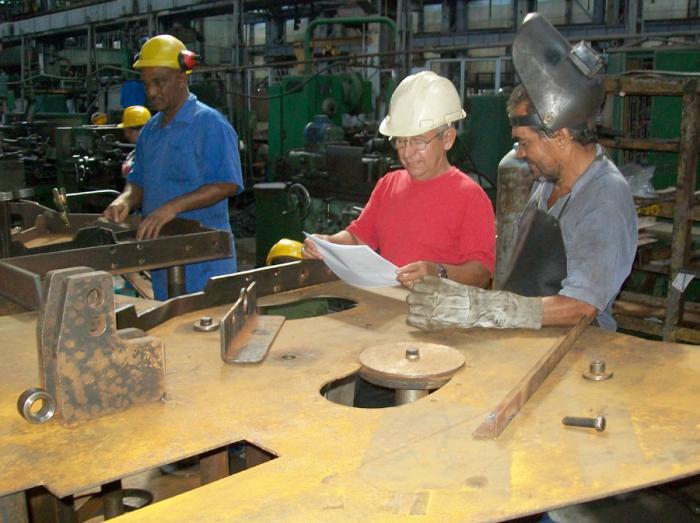
Holguín.— The implementation of the joint project between Cuba and China to manufacture CCA 5000 sugarcane harvesters, considered to be the machines best suited to conditions on the island, is underway at the 60 Aniversario de la Revolución de Octubre Enterprise.
The machine which is beginning to take shape in this factory will be the thirteenth destined for the Cuban sugarcane industry. The other five manufactured in China have already proved their worth in Cuban fields, which will soon see the arrival of seven more, also produced in China, according to mechanical engineer Manuel Quintero Boffil, senior quality management specialist at the factory.
“From now on, the industrial process – through which we aim to meet the demand by Azcuba for some 40 harvesters a year – will begin to stabilize with the progressive arrival of general pieces and components produced in China and the parts we are responsible for manufacturing,” he stated.
Boffil’s colleague Emilio Batista Suárez, also a mechanical engineer and technical management specialist, explained that the first harvester to be made in Holguín will be completed on scheduled and ready by the end of the year.
In this regard, he noted that all the structural elements, that is to say, chassis, discharge conveyors, extractors, feeders, and choppers, representing 80% of the body of the new harvester, will be manufactured at the facility; while the engine and cabin will come from China.
According to available information, the CCA 5000 sugarcane harvester is the most technically complex machine manufactured in the country.
“It’s a creation by specialists at Holguín’s Center for the Development of Agricultural Machinery (Cedema). The project already existed at the end of the 1990s, but was suspended due to a lack of financing,” stated Emilio, who described the harvester as a well thought out piece of equipment, demonstrated from the blueprint deign, through the prototype, and every stage of field tests.
In the tooling workshop, where time is of the essence given the magnitude of the workload, mechanical engineer Amoy Fernández Santiesteban, closely studying the technical documents, inspects the precise soldering of the chassis components, for which Omar Sánchez Segura and three other scrupulous mechanics, are responsible.
Amoy, who has been working for the enterprise for 34 years, stated that resuming the production of harvesters has breathed new life into staff and the workplace. He also noted that the project provides the country with useful machines to help support harvesting processes in the sugar fields; a sentiment shared by Omar, who ended the brief exchange stating that the production of harvesters represents another happy moment in the long history of the center.
MULTIFACETED PRODUCTION
The 60 Aniversario de la Revolución de Octubre workforce continues to demonstrate its ability to simultaneously assume various productive tasks. In this regard, business managerJuan Carlos González González pointed out that the entity produces replacement parts for KTP-2M harvesters. “We are responding to a request by Azcuba which includes 122 lines with over 38,000 physical units, among them discs, receiver parts, discharge conveyors, gear boxes, and steering wheels.”
Likewise, almost 1,500 different kinds of valves for irrigation systems used by the country’s rice producers, are scheduled to be completed by December according to a contract signed between the entity and the Ministry of Agriculture’s Aseguramiento al Grano Enterprise.
In the area where this equipment - vital for ensuring optimal water use in the fields – is assembled, engineer Urbides Aldazabal Romero, noted that in September the entity met unit production targets and established the conditions to begin modernizing a KTP–2M type harvester.
Regarding the valves, assembly technician Ronald Hernández Sariol noted that given precise quality control and the combined workmanship of the team, not a single one was rejected by the client.
Meanwhile, 117 dumpsters are scheduled to be produced by the end of this year as part of an agreement with Communal Services.
Thus far a reported 90 units, which meet the technical standards and operational requirements, have already been delivered.
September was also a month of intense activity in the welding and soldering workshop during which 12 dumpsters were completed.
“When we began work in July, we had no idea about this type of container, but staff’s technical training allowed us to quickly assimilate the productive process,” recalled Alexis Córdova Ricardo, an area supervisor.
The impact of the entity’s support to the Construction Guarantee Program has also been felt with the delivery of the 49 requested Vibracón machines, used to produce 10 by 15 by 20 centimeter concrete blocks; and 116 hammer mills or pebble grinders.
Another target met this year, according to Juan Carlos González, is the manufacture of over 70.13 cubic meter capacity tow-trailers designed by experts at the Caribbean Mechanical Industry (Imeca) and used to collect solid waste.
Pulled by tractors and featuring platforms on which Communal Service workers can safely stand while traveling from one stop to the next, these vehicles will contribute to keeping neighborhoods clean.
With production completed through September, including specific orders by local entities to resolve their problems, the 60 Aniversario de la Revolución de Octubre Enterprise has generated stable revenue which, according to its director, means that the facility is well on track to meet its 15.3 million peso sales target by the end of the year.















